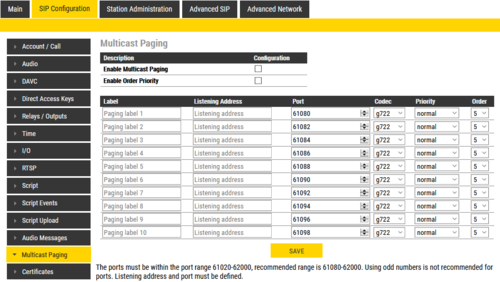Difference between revisions of "Multicast Paging (SIP)"
From Zenitel Wiki
| Line 39: | Line 39: | ||
** '''LOW / NORMAL''' priority: The paging audio is not played | ** '''LOW / NORMAL''' priority: The paging audio is not played | ||
** '''HIGH''' priority: The paging audio is mixed with the normal call | ** '''HIGH''' priority: The paging audio is mixed with the normal call | ||
| − | ** '''EMERGENCY''' priority: The | + | ** '''EMERGENCY''' priority: The regular call is muted |
Revision as of 13:39, 25 May 2018
Multicast Paging enables IP intercom stations in SIP mode to receive VoIP audio multicast paging from 3rd party iPBX (e.g. Asterisk). This feature is supported by both INCA stations and Turbine stations. Up to 10 different Multicast paging groups can be defined.
Configuration
To configure a station to receive Multicast Paging, log into the IP Station and select SIP Configuration > Multicast Paging:
- Enable Multicast paging: When enabled, the station is capable of playing audio received as Multicast
- Enable Order Priority:
- Enabled: If the station is exposed to two (or more) multicast VoIP streams at the same time, and the VoIP streams have the same priority, the VoIP stream with the highest "Order" number will be played.
- Disabled: The "Order" number will be ignored. If the station is exposed to two (or more) multicast VoIP streams at the same time, and the VoIP streams have the same priority, the first received VoIP stream will be played. Subsequent VoIP streams will not be played.
- Label: Any descriptive text
- Listening Address: The multicast IP address that the station shall liten to, e.g. 239.195.124.240. Multicast IP addresses are defined to be in the range from 224.0.0.0 to 239.255.255.255.
- Port: The port number must be within the port range 61020-61250, recommended range is 61080-61250. Using odd number for port is not recommended.
- Codec: Select between codecs G.711a, G.711u, G.722 and G.729
- Priority: Select which priority mechanisms should apply to this multicast VoIP stream. Options are LOW, NORMAL, HIGH (default), and EMERGENCY. See more details below.
- Order: If the station is exposed to two (or more) multicast VoIP streams at the same time, and the VoIP streams have the same priority, the VoIP stream with the highest "Order" number will be played. Requires that the "Enable Order Priority" option is enabled.
Paging priority
Multicast paging uses the same priority mechanism as Pulse Group call. Therefore, 4 different priorities are defined: LOW, NORMAL, HIGH, and EMERGENCY.
The priority mechanism has the following properties:
- A multicast page will terminate any ongoing page with lower priority. If two paging calls have same priority, then the one with highest order number gets priority.
- EMERGENCY priority includes a Volume and handset override feature:
- The volume is turned to maximum level on all receiving stations, and the audio is played on the loudspeaker, even if the handset is off-hook.
- During emergency page the station will queue all incoming calls. When emergency page ends, the station will accept calls again.
- If a station sends a busy override to a station listening on emergency page, then emergency page will stop
- If a station is in a regular point-to-point call when receiving a page of defined priority:
- LOW / NORMAL priority: The paging audio is not played
- HIGH priority: The paging audio is mixed with the normal call
- EMERGENCY priority: The regular call is muted



